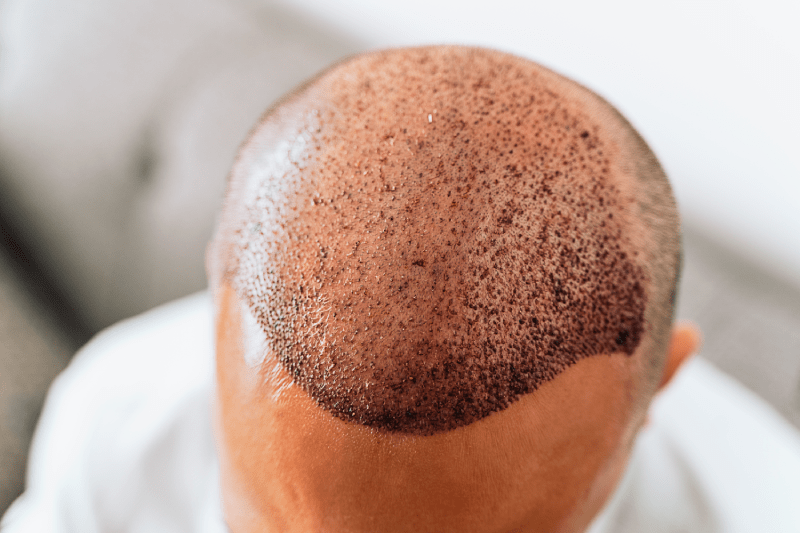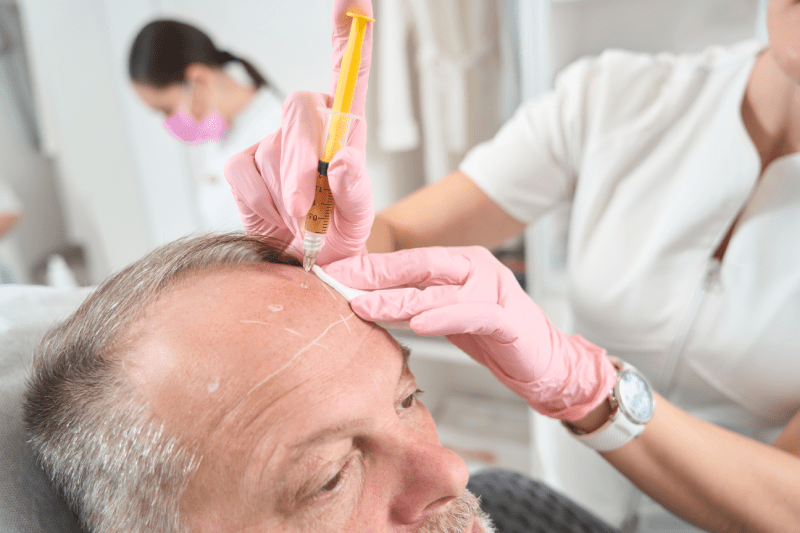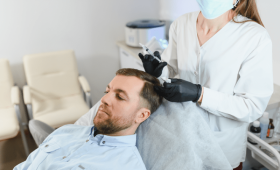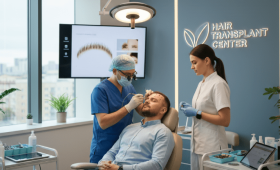What Is FUE Hair Transplantation And How Is It Applied?
FUE (Follicular Unit Extraction) hair transplantation is the process of extracting hair follicles one by one (unit by unit) from the donor area (usually the back of the head) and implanting them into the thinning area. In this procedure, follicles are harvested using micro motors or manual punches. The biggest advantage of FUE is that it does not leave a large linear scar, unlike the FUT technique. After the follicles are harvested, Sapphire tips or metal blades are used to open channels in the recipient area, and the grafts are placed into these channels. This minimally invasive method offers fast recovery and natural results, making it the most preferred technique today.
What Is The Average Cost For FUE Hair Transplantation In Turkey?
The average cost for FUE hair transplantation in Turkey is 60% to 75% lower than prices in Europe and the United Kingdom. This price varies according to the clinic’s quality, the technology used (Sapphire FUE is more costly), and the package content (including accommodation, transfers, and medication). Turkey’s low operational costs and the exchange rate advantage make prices this attractive. Patients, through Cure Holiday, can undertake an operation of international standards without straining their budget by deciding to receive treatment in Turkey with all logistical details sorted.
Why Are FUE Hair Transplant Prices More Affordable Than In Europe?
The fundamental reason why FUE hair transplant prices are so much more affordable than in Europe is Turkey’s low labour and general operating costs combined with the high value of foreign currencies. Although clinics use international technology of the same quality (e.g., Sapphire FUE devices), the unit cost decreases due to low personnel, rent, and laboratory expenses. This economic balance opens up great savings opportunities for patients coming from abroad and is a significant motivation for deciding to receive treatment in Turkey.
Can The FUE Technique Be Applied To All Hair Loss Types?
The FUE technique is generally suitable for patients experiencing hair loss due to Androgenetic Alopecia (male pattern baldness) and who have sufficient healthy and dense grafts in the donor area. The technique can be successfully applied across a wide range of baldness on the Norwood scale, from 2 to 6. However, it may not be suitable for those with a weak donor area, those with wound healing issues, or those with an active autoimmune disease (like Alopecia Areata). An expert analysis confirms whether FUE is the most suitable method for the type and level of baldness.
How Different Is The Sapphire FUE Technique From Classic FUE?
The Sapphire FUE technique differs from classic FUE only in the channel opening stage. While classic FUE uses steel-tipped metal blades, Sapphire FUE uses tips made from special Sapphire stone. These Sapphire tips open sharper, smoother, and micro-level channels. This results in less tissue trauma, less scabbing, and faster healing. Although Sapphire FUE is slightly more costly than standard FUE due to these comfort and aesthetic advantages, it is frequently preferred by the best clinics in Istanbul today.
What Is The Most Important Factor Affecting FUE Hair Transplant Success?
The most important factor affecting FUE hair transplant success is the experience and artistic vision of the specialist and team performing the operation. Success is hidden not only in the graft survival rate (generally 85% and above) but also in aesthetic details like natural hairline design, and implanting hairs at the correct angle and direction. Although high technology (Sapphire FUE) is important, ensuring the follicles remain viable and achieving a natural result depends entirely on the specialist’s skill. Therefore, expert selection should precede price criteria.

What Is The Maximum Number Of Grafts That Can Be Implanted In One Session?
In a healthy FUE operation, if the patient’s donor area has sufficient density and elasticity, a maximum of 4,000 to 5,000 grafts can be implanted in one session. This number is referred to as a “Mega Session”. Harvesting more than 5,000 grafts increases the risk of over-harvesting in the donor area and can lead to permanent thinning. Specialists take care not to exceed this maximum number to preserve both the blood supply to the recipient area and the aesthetic integrity of the donor area.
When Does Shock Loss Begin After FUE Technique Implantation?
The shock loss of hair implanted with the FUE technique generally begins between the 2nd week and the 2nd month after the operation. This shedding is the natural result of the transplanted hair shafts (not the roots) entering the resting (telogen) phase in response to trauma and is not a sign of failure. New and healthy hairs will start growing again from the place of the shed hair shafts after 3-4 months. Patients must be prepared for this temporary shedding process and be patient.
What Is The Required Stay In Turkey For FUE Hair Transplantation?
The required stay for international patients undergoing FUE hair transplantation in Istanbul is generally 3 days. This period covers Day 1: detailed examination and operation, Day 2: rest, and Day 3: mandatory first wash and control. The patient can safely return to their country on the fourth day. This short accommodation period prevents patients from taking a long leave from work and offers the logistical advantage of receiving treatment in Turkey.
Are Accommodation And Transfers Included In FUE Hair Transplant Packages?
Yes, corporate FUE hair transplant centers in Istanbul and intermediary institutions like Cure Holiday generally offer all-inclusive packages. These packages include VIP airport transfers and accommodation in 4 or 5-star hotels during the treatment period (usually 3 nights). These services eliminate the patient’s logistical stress in Istanbul, ensuring the patient focuses only on resting, and the total cost is determined beforehand.
How Long Does It Take For The FUE Hair Transplant Result To Fully Emerge?
The full and final result of FUE hair transplantation, including the hair completely growing out and thickening, becomes clear at the earliest between 12 and 18 months. New hairs start emerging from the 3rd month, and growth accelerates at the 6th month. During this period, hair shafts strengthen and thicken. Patients must follow this long process patiently. The final result represents the permanent and final state of the transplant.
What Mandatory Tests Are Required Before The Operation?
Mandatory tests required before FUE hair transplantation are critical for the safety of the operation and the patient’s general health status. These tests generally include checking for infectious diseases (Hepatitis B/C, HIV), bleeding and clotting times, and screening for systemic diseases like diabetes. These tests are mandatory to minimize the risk of complications during or after the operation and are generally included in the package price.
What Is Done To Prevent Hair Follicle Loss In The FUE Technique?
The most important steps taken to prevent hair follicle loss in the FUE technique are minimizing the time follicles spend outside the body and storing them in special cold/nourishing solutions (HypoThermosol). These cold storage conditions are vital for the follicles to remain viable. Furthermore, the sensitive work of the expert team during follicle harvesting and channel opening, as well as determining the correct angle and depth before implantation, play a critical role in preventing graft loss.

Why Is Smoking And Alcohol Consumption Forbidden After FUE Hair Transplant?
Smoking and alcohol consumption are the biggest risk factors that seriously jeopardize the success of FUE hair transplantation. Nicotine in cigarettes constricts blood vessels, inhibiting the blood flow and oxygenation vital for the grafts to adhere. Alcohol, on the other hand, thins the blood, increasing the risk of bleeding and prolonging the healing process. Specialists strictly require abstaining from these substances for at least one month before and after the operation for successful results and the continuation of the warranty conditions.
Is There An Option For Unshaven FUE And How Does It Affect Cost?
Yes, unshaven (unshaven) implantation options are available in the FUE technique. This method is suitable for areas requiring fewer grafts (hair densification) and eliminates the need to shave the entire head. Unshaven FUE is generally higher priced than standard FUE because it requires more precision and longer time. However, it is a valuable option for patients who want to return to social life quickly after receiving treatment in Turkey.
Which Supporting Treatments Do The Best Clinics Include In The FUE Package?
The best FUE hair transplant packages in Istanbul generally include the first PRP (Platelet-Rich Plasma) session to support the success of the operation and hair quality. PRP contains growth factors that accelerate healing and support the nourishment of transplanted follicles. Some premium packages may also include vitamin supplements or special lotions. These supplementary treatments aim to strengthen the final result of the transplant and contribute to the added value of receiving treatment in Turkey.
How Is A Natural Hairline Created In The FUE Technique?
Creating a natural hairline is the most critical artistic stage of FUE implantation. Specialists use single grafts at the front of the hairline, implanting them at very sharp angles (15-20 degrees) in a scattered and zigzag pattern suitable for the patient’s facial features. This precise placement prevents the hair from standing upright and looking like “doll’s hair,” guaranteeing a naturally transitioning line.
When Does The Scabbing That Forms On The Head After The Operation Completely Shed?
The scabbing that forms on the donor and recipient areas after the operation generally sheds completely within 10 to 14 days as a result of gentle washing performed with the special lotion and shampoos provided by the clinic. The shedding of these scabs is a vital phase of healing and shows that the healthy follicles have adhered to the skin. Patients must absolutely avoid forcibly removing the scabs, as this can cause graft loss.
How Long Does Pain And Swelling Last After FUE Hair Transplant?
The level of pain after FUE surgery is generally very low and localized to the donor area. Pain is usually completely controlled with prescribed painkillers within the first 2-3 days. Swelling (edema) usually peaks on the 3rd day after the operation and subsides on its own within 5 to 7 days. Modern clinics minimize pain by using needle-free anesthesia.
Is Hair Implanted With The FUE Technique Permanent?
Yes, hair implanted with the FUE technique is permanent and will not shed for a lifetime. This is because the transplanted follicles are harvested from the donor area (back of the head), which is genetically resistant to shedding. These follicles retain their resistance even in the new area. This permanence is the most fundamental advantage of FUE hair transplantation and ensures the patient’s investment is long-term.
How Long Should I Wait For A Revision Surgery (Second Session)?
If the first FUE transplant is considered unsuccessful or insufficient, it is generally necessary to wait 12 to 18 months for a second revision surgery. This period is critical for the final result of the first transplant to fully emerge and for the donor area to completely heal and recover. An early second operation may risk the first implant and can cause permanent damage to the donor area. Expert evaluation determines the correct timing for the second operation.

How Is Donor Area Damage Prevented In The FUE Technique?
Damage and permanent thinning (over-harvesting) in the donor area are prevented by homogeneously distributing the graft harvesting across a wide area and limiting the number of follicles harvested per square centimeter. Experienced specialists take care to ensure the donor area does not look visibly sparse even when the hair is cut short. This sensitive harvesting strategy is vital for preserving the aesthetic integrity of the donor area.
Which Sports Are Forbidden After FUE Hair Transplant?
Heavy cardio, weight lifting, and sports that pose a risk of impact to the head are strictly forbidden for the first 14 days after FUE hair transplant. Intense exercise raises blood pressure, increasing the risk of bleeding in the recipient area. Swimming in the pool or sea is also forbidden for the first 2 weeks due to the risk of infection. Patients are only allowed to take light walks during the first 14 days.
Which Surgical Equipment Is Used In FUE Technique In Istanbul?
The best FUE centers in Istanbul use single-use, sterile, and high-precision surgical equipment. These include Sapphire FUE blades (for channel opening), high-speed micro motors (for minimal graft damage), and special implantation tools. The use of this technological equipment directly increases the quality, speed, and graft survival rate of the operation, which is a significant quality advantage of receiving treatment in Turkey.
Are Long-Term Control Appointments Charged After FUE Hair Transplant?
Reliable clinics in Turkey generally offer periodic control appointments (6th month, 12th month) free of charge for 1 year after the transplant to track the success of the procedure. For international patients, these controls can be followed up online. The patient is only obliged to cover their travel expenses (airfare) for the controls. Regular check-ups are vital for the long-term continuity of the transplant’s success.
How Much Preparation Time Is Required Before Starting FUE Hair Transplantation?
The preparation process before FUE hair transplantation is short but crucial. Patients must abstain from alcohol, smoking, and blood-thinning medications (like aspirin) for at least one week before the operation. Special shampoos are used to cleanse the scalp. These preparations minimize the risk of bleeding and swelling and support the healthy adherence of the grafts. Adherence to these rules is mandatory.
Which Age Range Most Frequently Undergoes FUE Treatment?
The age range that most frequently undergoes FUE hair transplantation is generally between 25 and 45, where the hair loss pattern has stabilized. Specialists advise waiting for the hair loss pattern to fully stabilize to reduce the risk of future continued shedding. This age range offers the highest success and permanence rate because the quality of the donor area is still good.
Why Do Istanbul Clinics Generally Target Maximum Graft Count For FUE?
Istanbul clinics generally target maximum graft count (4,000 – 5,000) by including it in a single package price to ensure patients achieve the highest density. This approach eliminates the patient’s worry about counting grafts or extra costs. High density is the key to the aesthetic success of the FUE technique. This is an advantage stemming from Turkey’s low operational costs and increases the allure of receiving treatment in Turkey.
What Is Done To Improve Long-Term Hair Quality After FUE?
To improve long-term hair quality after FUE, treatments like PRP (Platelet-Rich Plasma), special vitamin and mineral supplements, and hair loss-slowing medications (Minoxidil, Finasteride) are generally recommended. PRP nourishes existing and implanted follicles, supporting hair thickening and quality improvement. These supportive treatments reinforce the final result of the FUE operation.

When Is The Risk Of Graft Loss Highest In The FUE Technique?
The risk of graft loss in the FUE technique is highest in the first 48 hours after the operation due to trauma, impact, or friction. Additionally, the follicles staying outside the body for too long or being stored in inadequate solutions increases the risk of viability loss. Experts emphasize the importance of passing the first 48 hours carefully; adherence to the no-touching rule is critical.
Does The FUE Technique Leave A Permanent Scar?
No, FUE hair transplantation does not leave a permanent linear scar (unlike FUT). Only micro-level, pinhead-sized punctate scars remain in the donor area where the follicles are harvested. These scars are generally not noticeable even when the hair is cut short and fade over time. This aesthetic advantage is the main reason why FUE is the most preferred method.
How Is The Angle Of Hair Determined In FUE Technique Implantation?
The angle of hair in FUE implantation is the most critical factor for a natural appearance. Specialists determine the angle and direction (generally 30-45 degrees, 15-20 degrees at the front) by mimicking natural hair growth. Sapphire FUE tips ensure this angle is achieved with millimetric precision. Incorrect angle (e.g., 90-degree upright) leads to an artificial appearance.
What Is The Most Suitable Season For FUE Surgery In Turkey?
There is no medically most suitable season for FUE surgery; it can be performed safely in any month. However, for patient comfort, Spring and Autumn (less sun and heat) are generally recommended. Surgery can be done in summer too, but the patient must strictly protect the area from the sun and sweat for the first 14 days. This flexibility allows for combining the operation with travel.
When Does The Redness That Occurs After Hair Transplant Disappear?
The redness that occurs in the recipient and donor areas after FUE hair transplantation is expected. This redness generally significantly reduces within the first 1 to 2 weeks and disappears completely, depending on the skin type, within 1 to 3 months. Protecting the area from the sun and heat accelerates the resolution of redness.
Can Hair Implanted With The FUE Technique Be Shaved?
Yes, hair implanted with the FUE technique can be shaved and cut after it fully grows out and strengthens (generally 6-8 months later). It is strictly forbidden to use a razor or machine on the recipient area for the first six months. This period is required for the roots to fully adhere. After the 8th month, the hair can be cut and styled like normal hair.
Can FUE Technique Be Used For Eyebrow Or Beard Transplantation?
Yes, the FUE technique is the most preferred method for eyebrow and beard transplantation. The micro-precision of FUE is ideal for achieving natural angle and density in these aesthetic areas. Since fewer grafts are generally needed for beard and eyebrow transplantation, the operation time is shorter than hair transplantation.
How Does Cure Holiday Support The FUE Hair Transplant Process?
Cure Holiday acts as a bridge of trust, quality, and organization in the FUE hair transplant process. It selects the best JCI-accredited expert centers suitable for the patient’s budget. It manages all the logistical processes (VIP transfer, luxury accommodation) and provides uninterrupted interpreter support, ensuring the patient receives stress-free, economical, and high-quality treatment by deciding to receive treatment in Turkey.
Is The Use Of Hair Loss Preventing Medication Mandatory After FUE?
The use of hair loss-preventing medications (e.g., Minoxidil or Finasteride) after FUE is not mandatory for the implanted hair (as it is permanent) but is recommended for protecting the existing original hair. These medications slow down the shedding of existing hair, which prevents the difference in density between the transplanted and native hair from increasing over time and supports the aesthetic continuity of the result.



